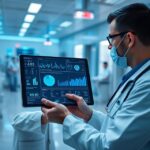How Data Science is Changing the Food Industry
Introduction
The food industry is a huge part of our daily lives, but it’s constantly changing. From the way food is grown to how it gets delivered to us, data science is playing a major role in making the whole process smarter. Whether it’s helping restaurants serve meals faster, reducing food waste, or keeping our food safe, data science is making things more efficient and better for the environment.
Data Science in Food Production
At the start of the food journey, data science is helping farmers make smarter decisions. It’s no longer just about working hard and relying on experience—today, farmers are using data to increase crop yields, reduce waste, and keep food safe.
How It Works:
Farmers use sensors in their fields to gather data on things like the weather, soil moisture, crop health, and pest activity. With machine learning, farmers can get real-time insights on when to water their crops, apply fertilizers, or take action against pests. This helps them produce more food with fewer chemicals and resources.
Example:
Companies like IBM’s Watson are helping farmers with something called “precision agriculture.” This uses data to predict which parts of a field need more attention and which crops will do best based on the weather. This helps farmers avoid wasting resources and makes farming more sustainable.
Benefits:
- Higher Crop Yields: By understanding growing conditions, farmers can produce more food.
- Reduced Resource Waste: Water and fertilizers are used more efficiently.
- Sustainability: Data-driven farming uses fewer pesticides, which is better for the environment.
Data Science in Food Safety
Food safety is critical, and data science is helping ensure the food we eat is safe by improving how we track food from farm to table.
How It Works:
Data is collected all along the food supply chain, using sensors and IoT (Internet of Things) devices. For example, temperature sensors in delivery trucks ensure food stays at the right temperature. If something goes wrong, like a temperature fluctuation that could spoil the food, the system alerts everyone involved to fix the issue quickly.
Example:
Blue Diamond Growers uses blockchain and data science to trace almonds from the orchard to the consumer. This not only helps ensure quality but also builds trust with customers who want to know where their food comes from.
Benefits:
-
Improved Traceability: Data makes it easier to track food, reducing contamination risks.
-
Quicker Response: Problems like food recalls can be addressed faster by identifying the source in real time.
-
Consumer Confidence: Transparency in food safety practices reassures customers about quality.
Optimizing the Supply Chain with Data Science
The logistics of getting food from producers to consumers has always been a challenge. In the past, this often led to waste and spoilage. But with data science, companies can make their supply chains more efficient and reduce food waste.
How It Works:
Data science looks at things like weather patterns, demand fluctuations, and consumer behavior. By using predictive analytics, businesses can forecast demand more accurately, so they know how much food to produce, transport, and store. This helps avoid overproduction and reduces waste.
Example:
Companies like Tesco are already using data science to predict how much of each product they’ll need in different locations. This means less food ends up unsold and wasted.
Benefits:
- Reduced Food Waste: Accurate forecasting means less food is thrown away.
- Cost Savings: Businesses spend less on spoiled or unsold inventory.
- Faster Deliveries: Real-time data helps ensure food gets to the right place on time.
Data Science in Restaurant Operations
In restaurants, data science is making businesses run more smoothly and improving the customer experience. By analyzing customer preferences and behaviors, restaurants can tweak their menus, optimize staffing, and predict which dishes will be popular at different times.
How It Works:
Data tools track things like customer preferences, orders, and feedback in real time. This helps restaurants adjust their menus to match what customers want and optimize staffing to handle busy hours. It also helps with inventory management, so restaurants don’t overstock ingredients.
Example:
Domino’s uses data science to improve delivery times and predict the best routes for drivers. By analyzing traffic patterns, weather, and order history, they can make sure your pizza arrives quickly and hot.
Benefits:
- Better Customer Experience: Restaurants can offer what customers want.
- More Efficient Operations: Data helps manage staffing and inventory.
- Faster Service: Real-time data helps restaurants serve customers quicker.
Food Delivery and Customer Satisfaction
Food delivery has become a huge part of the food industry, especially with platforms like Uber Eats, DoorDash, and Grubhub. These platforms rely on data science to get food to customers quickly and efficiently, all while keeping costs down.
How It Works:
Food delivery apps use data to track orders, predict delivery times, and optimize routes for drivers. They analyze past data to predict busy times, so they can make sure enough drivers are available. Machine learning also helps forecast demand, so restaurants know what to prepare in advance.
Example:
UberEats uses machine learning to calculate the estimated delivery time for each order, factoring in things like the driver’s location, traffic, and restaurant prep times. This helps customers know exactly when their food will arrive.
Benefits:
- Faster Delivery Times: Accurate predictions help drivers take the quickest routes.
- Improved Efficiency: Apps can adjust to spikes in demand, making service more reliable.
- Better Customer Experience: Real-time delivery updates give customers a clearer picture of when their food will arrive.
Conclusion
Data science is revolutionizing the food industry in many exciting ways. From farming and food production to restaurant operations and food delivery, data is making things more efficient, sustainable, and customer-friendly. As data continues to shape the food industry, we can expect even more innovations that make our food safer, more personalized, and better for the planet. Whether it’s reducing waste, improving safety, or making dining experiences more tailored to our tastes, data science is helping the food industry get smarter every day.







